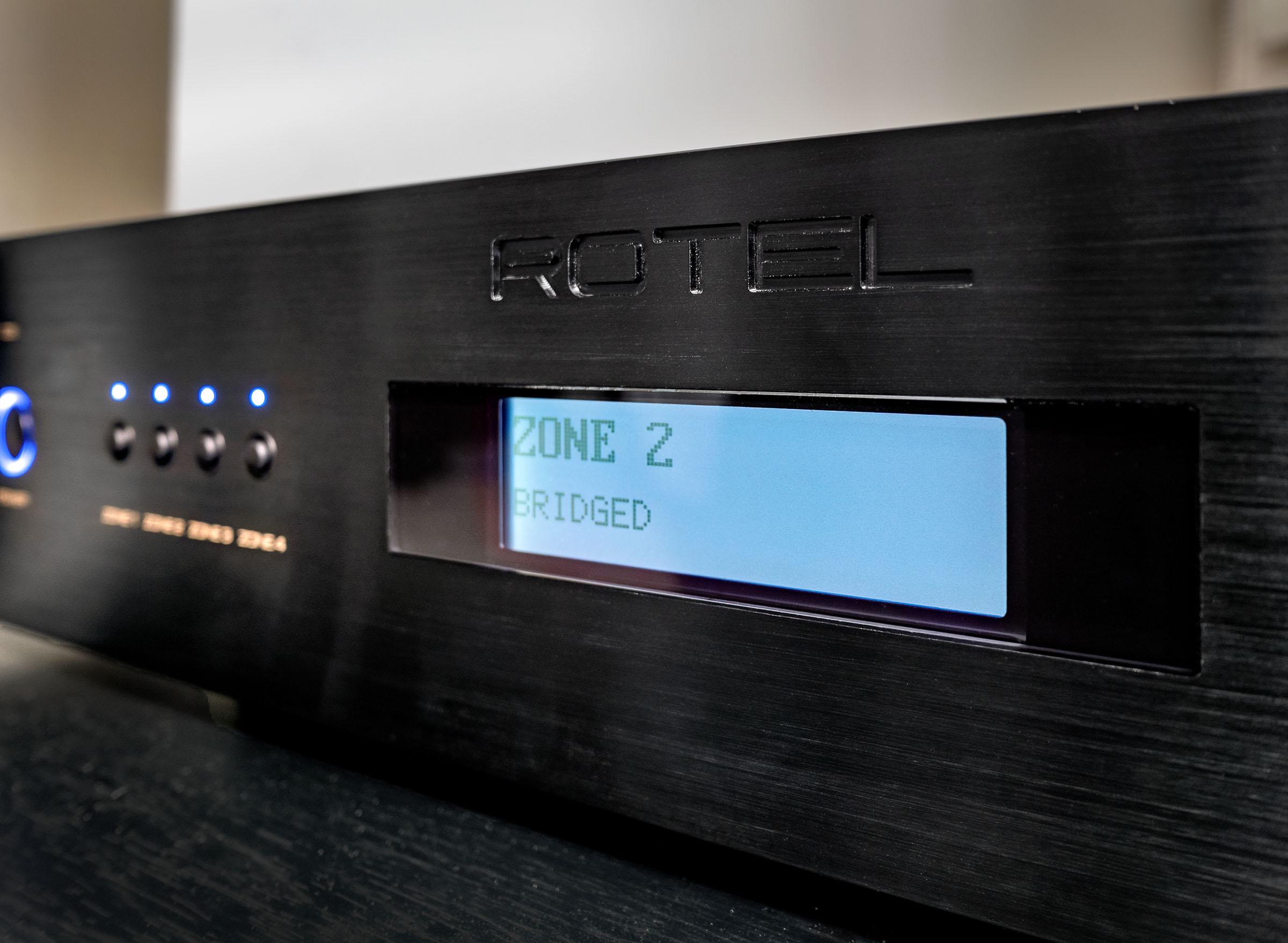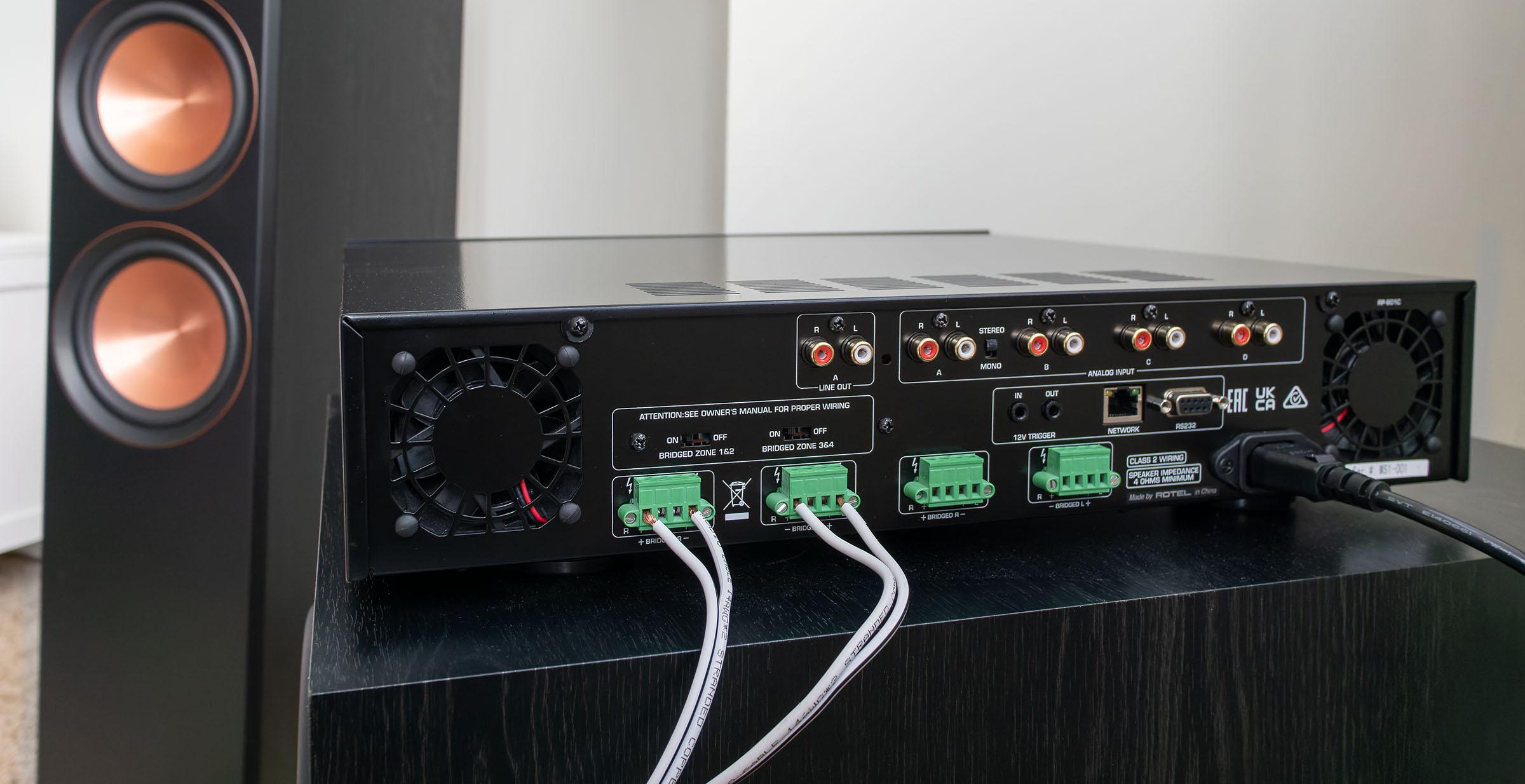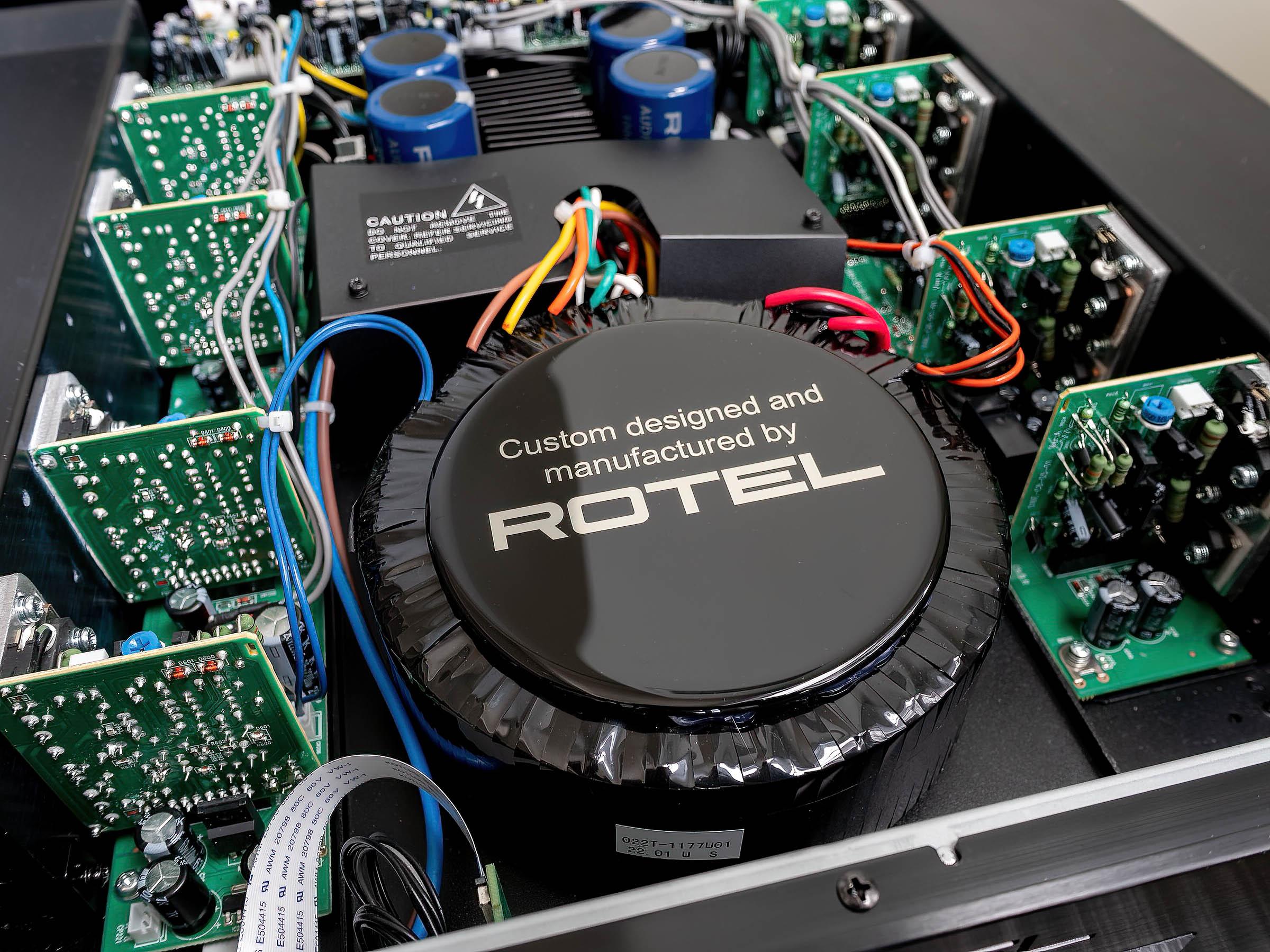
Rotel's rackmount, multi-channel amplifier takes the company's design philosophy and distills it into an incredibly dense and compact design. The new C8 distribution amplifier ($2599) is a class A/B design built to audiophile standards but engineered to fit in a 2U rack space. It can deliver high-fidelity audio in various custom install applications ranging from multi-room audio to home theaters.
Notably, this rack-mountable amplifier does not stick a DSP processor in the signal chain. It is an analog device engineered for transparency while any EQ and room correction is taken care of elsewhere, earlier in the signal chain. Even the C8+ variant of the amp—which has an integrated DAC—keeps the tone controls in the analog domain.
The C8 offers 70 W per channel into 4 ohms at full power, 8-channels driven, or 50 W per channel into 8 ohms. When running in bridged mode, power output doubles to 140 W per channel and 100 W per channel into an 8-ohm load.
Rotel divides the eight channels into four zones (A, B, C, D), each consisting of a stereo channel pair). Two switches on the rear of the unit allow you to selectively bridge zones one and two and/or zones three and four.

This amp provides four stereo inputs (unbalanced RCA), which are matrixed to the zones. There's a switch that lets you select Mono for the input. This provides significant flexibility, and you can choose to have one input go to all the zones or assign the inputs discretely based on need.
Total harmonic distortion (THD) is rated as under 0.1%, and the frequency response is 10 Hz to 100 kHz ±0.5 dB with a signal-to-noise ratio of 100 dB at the line-level inputs.
With feet attached, the amp's dimensions measure 17" W × 3.9" H × 16.3" D, but without the feet, the amp is 2U/3.5" high and requires zero clearance on top or bottom. It weighs 36.81 pounds (16.7 kilograms), which feels very dense considering its size. But when you have fans to help with cooling, you don't need huge heat sinks or a big chassis to dissipate the heat, and you can fit everything inside the smaller space—including a toroidal transformer—nice and tight.
Integrated fan cooling ensures that the amplifier remains properly ventilated when in a rack and allows it to sit within a stack of AV gear— for example, underneath an AV receiver—without any thermal issues.
The faceplate of this amp has the Rotel aesthetic, so if it is visible, it'll stylishly blend in with other gear, unlike some rackmount amps that pay no attention to appearances.
Regarding the tone controls, this amplifier feeds the analog signal into an analog tone controller IC. It receives digital control signals from the menu system, allowing you to adjust settings as if on a digital device. This arrangement enables the amp to change volume levels and balance and either boost or cut bass/treble by ±10 dB in 1 dB steps. The bass tone control is centered around 100 Hz, while the treble tone control is centered around 10,000 Hz. The output from this IC directly feeds the amplifiers.
One thing to note is that this amplifier does not have the classic speaker cable termination you see on consumer amps. Instead, it uses Phoenix-style connectors, commonly used by pros/custom installers. Long story short, you need a screwdriver to connect speaker cables, but once you attach the connector, plugging and unplugging them is super easy. Just follow the wiring diagram for where to connect the cable, depending on whether the amp is bridged or not.

The ability to bridge channels and double the output is intriguing because it makes the C8 a viable option for adding external amplification to an AVR or for use as amplification when paired with a pre/pro.
Given that I don't have a multi-room audio system, I used the amp to power my 5.1.2 surround-sound system for this review, with a Denon AVR-X8500h AVR acting as the processor. In this system, a Chromecast Ultra is the primary source for music and video content, but I also have an Xbox Series X and an Apple TV 4K hooked up.
I also used the amp in bridged mode to power a pair of Klipsch Reference Premiere RP-8000F II speakers. For this setup, a MOTU M4 USB audio interface served as the DAC, and Roon + Tidal running on a PC was the source.
Setting up the amp is easy enough, given that the menus are simple and easy to navigate. There's a screen on the front of the amp (which you can have time out and go dark), and there are buttons to navigate. The upshot is that while all of your adjustments are in the analog domain, you get a programmable digital interface's ease, clarity, and precision.
I try to keep amplifier reviews short because, in the end, they are relatively simple devices with only one job to do: Transparently amplify an audio signal. But, I also strongly appreciate the qualities a good amp brings to the table. Power, precision, and clarity are needed to get the most out of a speaker system.
The Klipsch speakers in my system (at the time of this review) are rated at 8 ohms, so when running as a 4-zone, 8-channel amp per Rotel's specs, the C8 is serving 50 watts to each channel. However, the speakers are fairly efficient and don't need a lot of watts to get loud. For my application—home theater, with an 80 Hz crossover to the subs—the amp has plenty of headroom, so I did not come close to testing its limits.
It seemed to me that the C8 had a very easy time handling home theater duties. In some ways, powering a surround-sound system is actually not as tough on an amp as playing music through all eight channels simultaneously. The reason is with the music, the dynamic peaks hit all the channels simultaneously, which requires a robust power supply like the toroidal transformer Rotel uses in the C8.
With movie sound, there may be a lot of channels in the mix, but is rare for all the channels to peak concurrently. Instead, the dynamic peaks are temporally offset, or simply not present in all channels, which is how AVRs manage to keep up in terms of power output, despite having relatively small power supplies. And all this is my long-winded way of saying the Rotel C8 amplifier had a very easy time handling classic home theater tasks, easily providing its full power output to all channels.
The hardest job in a multi-channel system is driving the center channel. In my system, that center is the Klipsch RP-504C which is an 8-ohm speaker with 50-25kHz ±3dB response and 150 W power handling. But it's also high sensitivity and therefore gets as loud as I need with just the power provided by the C8. Indeed, there seems to be plenty of headroom because when I connected a Kill-A-Watt meter, I noticed that the amp's power draw typically stayed under 100W, and I had to deliberately push it by using pink noise and driving all channels simultaneously if I wanted to force it into drawing anywhere near the maximum rated current.
What I really like about using the Rotel—instead of the AVR's amps—is how the C8 efficiently and silently disposes of heat through the rear vents. This is a major point of differentiation versus many other "pro" rackmount amps I have used in my home system— those all had loud fans, that I wound up having to swap out with quieter computer fans. But the C8's cooling is both effective and inaudible (with my AVR, I use a dedicated rear-venting top-mounted fan from AC Infinity to keep things cool).
I hardly see the point in describing how an amp "sounds" in a system that uses room correction. The amplifier's job is not to stand out and sound like anything in particular. Its job is to disappear and not screw up! But if you are interested in what I'm watching lately, in the course of the review, I checked Out The Unbearable Weight Of Massive Talent, Spider-Man No Way Home, The Batman, and Moonfall. The movies had all the clarity, impact, and envelopment I expect from a high-end rig, no signs of petering out when the action gets intense, and dialog was always perfectly legible.
While AV receiver specifications typically cite a higher wattage, that specification is usually for one or two channels driven. When you measure an AVR with all channels driven, the per-channel wattage drops dramatically, unlike with this amplifier which meets its specs with all channels driven.
All I'm looking for out of any quality amplifier is transparency and good thermal management. Of course, those specific demands could easily lead to an extensive conversation about the qualities of class-A, class A/B, and class-D amplification—the three amp topologies you are most likely to encounter as a consumer. TO keep it short, with its decision to stay analog and pursue a robust class A/B design in such a compact form factor, Rotel is making a statement: You can have classic, audiophile-quality amplification in a custom install-friendly rackmount format.
But that's the funny thing about the C8; it need not be rack mounted. And to that end, the rack mount ears are detachable. For the 2-channel, bridged, full-range listening I set up the C8 as one would an audiophile amp. I engaged bridge mode for all the zones, resulting in a 4-channel amp. I then bi-amped the Klipsch towers by using the menu controls to send each input channel to two output channels. The internal channel routing is quite handy.
And voila! That's all it took for the Rotel C8 to go from serving as a rackmount, multi-channel amp to a quite serious stereo amplifier that, best I could tell, left nothing on the table performance-wise while pushing large, powerful tower speakers.
With the 2-channel rig, I could appreciate the level of fidelity achieved by Rotel. We're talking about a proper audiophile-quality presentation with all the fixings, from rock-solid holographic imaging to micro-dynamics transmitting tangible textures through precise modulation (i.e. yes, I like dubstep).
With the Klipsch towers and this amp, the resulting stereo sound is arguably as good as you'd expect from dedicated 2-channel amplification, as opposed to an 8-channel distribution amp. And that is what the C8 is about, in a nutshell. It'll do justice to good speakers and provide an authentic audiophile-quality stereophonic listening experience if you give it a chance.
As for what I'm listening to lately, that I thought sounds great through the Rotel/Klipsch/MOTU system? I have yet to grow tired of Binary by Sounds from the Ground, an instrumental electronic album that is the essence of chill, my morning wakeup album for sure but also a float-away listening experience that shows off the imaging of good speakers. With the Rotel running the show, these new Klipsch towers put on a surprisingly sophisticated performance where the soundstage had great depth, width, and the individual sounds were clearly defined in terms of position and scale.
When I want to stretch a 2-channel rig, I reach for the classic, highly recognizable "O Fortuna" from Carmina Burana, particularly the rendition by Herbert Blomstedt with the San Francisco Symphony and Chorus, recorded in 1990. I bought that album when it came out and have used it as a point of reference for every system over 3 decades, a fact that is true for very few albums.
People complain that dynamic compression sucks the life out of modern music. This is why I had a huge smile on my face when the crescendo arrived and the tympany hits, it struck me with visceral impact. Yes! Properly rendered classical music—good enough to create some endorphins—on a system that all-in (Rotel C8, Laptop to run Roon, MOTU M4, Klipsch RP-8000 II) costs under $5000. That's brilliant!
Having found no issues with how it sounds, I decided to just straight-up torture test the amp. So I launched REW (Room EQ Wizard) and started feeding the Klipsch speakers pure sine wave bass. I was happy to see the amp keep pushing the drivers, even when I dropped the frequency down to single-digit Hz. Even at 2 Hz, the amp was still moving the woofers in and out quite extensively, in what looks like slow-motion.
With a 16 Hz tone, I can push the cones to their physical excursion limits without clipping or audible distortion from the amp. What I was not able to do is trigger any audible fan noise from the amp, which I would have expected when asking it to output a 16Hz sine wave continuously. Overall, the amp stayed remarkably cool while playing the infrasonic bass tones.
The Rotel C8 is (basically) two amps in one. It is a custom install-friendly rack-mountable amp and an audiophile-quality standalone amplifier. In either guise, it's an all-analog class-A/B design that can run in a 4-channel, 6-channel, or 8-channel configuration while offering great sound and ease of use.
Subjectively speaking, this Rotel sounds fantastic, operates reliably, looks sharp, and is easy to use. What I do not know is how it performs on a test bench, so I make no promises in that regard. Notably, if you like the design, but need more capability than what the C8 offers, there's a C8+ ($3199) that more than doubles the power output specs and adds a built-in DAC with optical-digital and coaxial inputs—but otherwise is the same design.
There's quite a bit of functionality within the C8 amp that's aimed at custom installers and distributed audio applications. But I openly confess that this aspect of AV is not my specialty. My interest is in the bottom line: How does the amp sound and perform in my system? The short answer is that it functions perfectly.
However you use it, the C8 is rock-solid, cool running, great-sounding, and just plain a nice-looking piece of kit. It’s a flexible, adaptable amp that bridges the gap between the audiophile and custom install worlds, and therefore it easily picks up an Editor's Choice award for 2022.